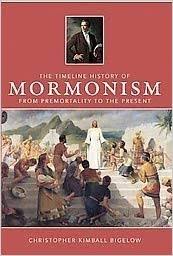Articles/Essays – Volume 42, No. 3
Time Tabled by Mormon History | Christopher Kimball Bigelow, The Timeline History of Mormonism from Premortality to the Present
Christopher Kimball Bigelow’s The Timeline History of Mormonism: From Premortality to the Present has the appearance of a coffee table book: It’s too large to fit in a standard bookcase, it’s brimming with eye-catching visuals, and it has multiple points of entry for dinner guests who find a few minutes to skim through its pages. However, its contents really lend themselves most readily to the classroom. Upon closer inspection, it’s a reference book that had to adopt an oversize format with fold-out pages in order to convey a vast amount of information in an accessible manner. However, much of the material is presented well below a 10-point font, so I suggest keeping your eyeglass prescriptions current if you are going to pick up a copy. Because The Timeline History of Mormonism is so information rich, it would be best employed by those who want to learn more about the Church of Jesus Christ of Latter-day Saints. I can imagine a variety of readers, ranging from seminary students to investigators to those curious about how a small American church has transformed itself into an international religion of 13 million members in less than two centuries.
Bigelow’s title implies that the book is primarily a timeline. The first third of the book lives up to the title by presenting a list of events in three “streams” of information with world events listed on the top stream, events from the Book of Mormon in the middle stream, and events from the Old and then New Testament on the bottom stream. Several pages of the timeline fold out to reveal maps or portraits pertinent to that era. I thought perhaps the timeline would continue by cross-listing events to specific sections of the Doctrine and Covenants. However, that nineteenth-century scriptural text does not serve as an anchor in the same way the Bible and Book of Mormon served in the earlier pages of the timeline. Instead, events from LDS Church history are presented without Doctrine and Covenants references, probably because Church events are listed into the twentieth century, well beyond D&C time (with the exception of one section and one official declaration).
After the timeline concludes, the book’s next two thirds contain entries that parallel material found in encyclopedias or almanacs: doctrine, Church leaders, Church growth, and notable LDS personalities in politics, science, business, sports, and entertainment. These lists are in no way exhaustive, but they show read ers that Mormons are achievement oriented and have become more a part of the mainstream, in contrast to, for instance, the 1838 Haun’s Mill Massacre in Missouri or B. H. Roberts’s being denied his seat in the House of Representatives in Washington, D.C., after his 1898 election. The book also points readers to additional sources of information: publications, websites, museums, pageants, and historical sites.
The thousands of disparate facts presented in this book are interesting. However, their organization and presentation interest me more because they make an indirect argument about the relationship between the Mormon faith and the history of the world. The view of time presented in this book subsumes all time—past, present, and future—into the LDS narrative. New students of the Mormon faith might expect to find Joseph Smith’s birthday listed as the first event in the Church’s history. Not so. The timeline reaches back to Adam and Eve. In a later section on key LDS doctrines, time actually starts with premortal events that determined the relationship among the Godhead and the human race. After Joseph Smith and the restoration of the primitive church, the timeline narrows to focus on events within the Mormon Church’s development and expansion.
The events read more like a funnel that is very expansive in listing events in the past but which narrows with Joseph Smith’s appearance and, from that point on, presents only those events that can be funneled into the Mormon experience. World events before Joseph Smith contain a number of references to world religions, especially to Christianity (for example, various Bible translations, the Reformation, etc.). However, after Joseph Smith and the organization of the Church of Jesus Christ of Latter-day Saints, no other religious events appear on the world timeline, not even Vatican II in the 1960s. The only possible exception might be: “The nation of Israel is founded [1948] as the world’s only Jewish state,” which can be viewed as a fulfillment of prophecy and hence as an aspect of LDS doctrine (21). Many world events listed on the timeline for the nineteenth and twentieth centuries are related to innovations in science and technology, particularly those technologies—such as the development of the telephone, the computer, and the internet— that have assisted the LDS Church in its expansion. So while events in the history of other world religions disappear in Bigelow’s rendering of the last two centuries, the book emphasizes the LDS Church’s association with these scientific and technological icons of human progress.
The book concludes with a fold-out family tree that allows the reader to record six generations of family history. I see this chart as an invitation for the readers to become part of the all-encompassing history presented on the timelines, charts, maps, and summaries of doctrine. Not only does the influence of the LDS Church reach far into the past and far into the future, it reaches as far as 13 million people worldwide and as near as the individual holding this book in his or her hands.
Christopher Kimball Bigelow. The Timeline History of Mormonism from Premortality to the Present. San Diego, Calif.: Thunder Bay Press, 2008. 64 pp. Cloth: $19.95; ISBN: 978-1-59223-962-7


 Back to full Issue
Back to full Issue

